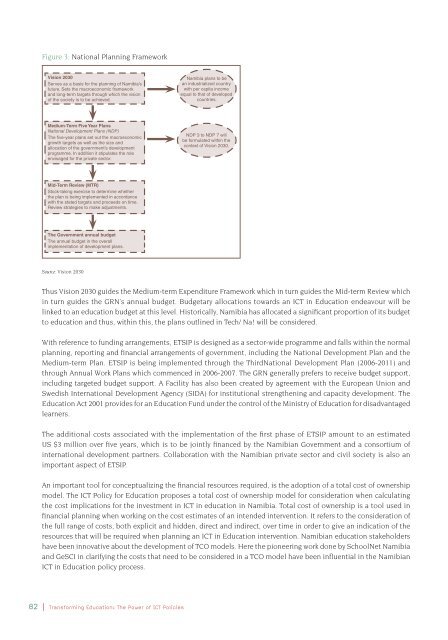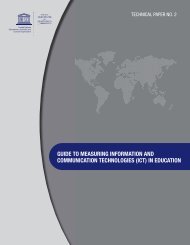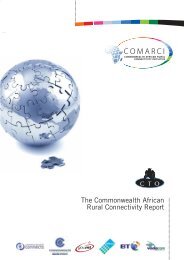Transforming education: the power of ICT policies - Commonwealth ...
Transforming education: the power of ICT policies - Commonwealth ...
Transforming education: the power of ICT policies - Commonwealth ...
You also want an ePaper? Increase the reach of your titles
YUMPU automatically turns print PDFs into web optimized ePapers that Google loves.
Figure 3: National Planning Framework<br />
Vision 2030<br />
Serves as a basis for <strong>the</strong> planning <strong>of</strong> Namibia’s<br />
future. Sets <strong>the</strong> macroeconomic framework<br />
and long-term targets through which <strong>the</strong> vision<br />
<strong>of</strong> <strong>the</strong> society is to be achieved.<br />
Medium-Term Five Year Plans<br />
National Development Plans (NDP)<br />
The fi ve-year plans set out <strong>the</strong> macroeconomic<br />
growth targets as well as <strong>the</strong> size and<br />
allocation <strong>of</strong> <strong>the</strong> government’s development<br />
programme. In addition it stipulates <strong>the</strong> role<br />
envisaged for <strong>the</strong> private sector.<br />
Mid-Term Review (MTR)<br />
Stock-taking exercise to determine whe<strong>the</strong>r<br />
<strong>the</strong> plan is being implemented in accordance<br />
with <strong>the</strong> stated targets and proceeds on time.<br />
Review strategies to make adjustments.<br />
The Government annual budget<br />
The annual budget in <strong>the</strong> overall<br />
implementation <strong>of</strong> development plans.<br />
Source: Vision 2030<br />
82 | <strong>Transforming</strong> Education: The Power <strong>of</strong> <strong>ICT</strong> Policies<br />
Namibia plans to be<br />
an industrialized country<br />
with per capita income<br />
equal to that <strong>of</strong> developed<br />
countries.<br />
NDP 3 to NDP 7 will<br />
be formulated within <strong>the</strong><br />
context <strong>of</strong> Vision 2030.<br />
Thus Vision 2030 guides <strong>the</strong> Medium-term Expenditure Framework which in turn guides <strong>the</strong> Mid-term Review which<br />
in turn guides <strong>the</strong> GRN’s annual budget. Budgetary allocations towards an <strong>ICT</strong> in Education endeavour will be<br />
linked to an <strong>education</strong> budget at this level. Historically, Namibia has allocated a signifi cant proportion <strong>of</strong> its budget<br />
to <strong>education</strong> and thus, within this, <strong>the</strong> plans outlined in Tech/ Na! will be considered.<br />
With reference to funding arrangements, ETSIP is designed as a sector-wide programme and falls within <strong>the</strong> normal<br />
planning, reporting and fi nancial arrangements <strong>of</strong> government, including <strong>the</strong> National Development Plan and <strong>the</strong><br />
Medium-term Plan. ETSIP is being implemented through <strong>the</strong> ThirdNational Development Plan (2006-2011) and<br />
through Annual Work Plans which commenced in 2006-2007. The GRN generally prefers to receive budget support,<br />
including targeted budget support. A Facility has also been created by agreement with <strong>the</strong> European Union and<br />
Swedish International Development Agency (SIDA) for institutional streng<strong>the</strong>ning and capacity development. The<br />
Education Act 2001 provides for an Education Fund under <strong>the</strong> control <strong>of</strong> <strong>the</strong> Ministry <strong>of</strong> Education for disadvantaged<br />
learners.<br />
The additional costs associated with <strong>the</strong> implementation <strong>of</strong> <strong>the</strong> fi rst phase <strong>of</strong> ETSIP amount to an estimated<br />
US $3 million over fi ve years, which is to be jointly fi nanced by <strong>the</strong> Namibian Government and a consortium <strong>of</strong><br />
international development partners. Collaboration with <strong>the</strong> Namibian private sector and civil society is also an<br />
important aspect <strong>of</strong> ETSIP.<br />
An important tool for conceptualizing <strong>the</strong> fi nancial resources required, is <strong>the</strong> adoption <strong>of</strong> a total cost <strong>of</strong> ownership<br />
model. The <strong>ICT</strong> Policy for Education proposes a total cost <strong>of</strong> ownership model for consideration when calculating<br />
<strong>the</strong> cost implications for <strong>the</strong> investment in <strong>ICT</strong> in <strong>education</strong> in Namibia. Total cost <strong>of</strong> ownership is a tool used in<br />
fi nancial planning when working on <strong>the</strong> cost estimates <strong>of</strong> an intended intervention. It refers to <strong>the</strong> consideration <strong>of</strong><br />
<strong>the</strong> full range <strong>of</strong> costs, both explicit and hidden, direct and indirect, over time in order to give an indication <strong>of</strong> <strong>the</strong><br />
resources that will be required when planning an <strong>ICT</strong> in Education intervention. Namibian <strong>education</strong> stakeholders<br />
have been innovative about <strong>the</strong> development <strong>of</strong> TCO models. Here <strong>the</strong> pioneering work done by SchoolNet Namibia<br />
and GeSCI in clarifying <strong>the</strong> costs that need to be considered in a TCO model have been infl uential in <strong>the</strong> Namibian<br />
<strong>ICT</strong> in Education policy process.
















